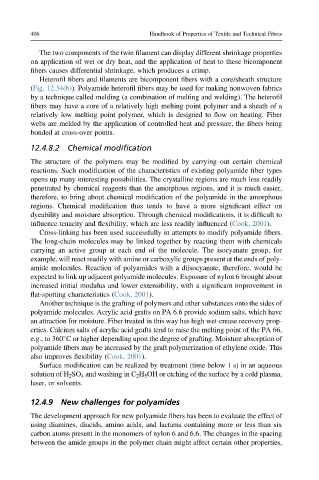Page 433 - Handbook of Properties of Textile and Technical Fibres
P. 433
406 Handbook of Properties of Textile and Technical Fibres
The two components of the twin filament can display different shrinkage properties
on application of wet or dry heat, and the application of heat to these bicomponent
fibers causes differential shrinkage, which produces a crimp.
Heterofil fibers and filaments are bicomponent fibers with a core/sheath structure
(Fig. 12.34(b)). Polyamide heterofil fibers may be used for making nonwoven fabrics
by a technique called melding (a combination of melting and welding). The heterofil
fibers may have a core of a relatively high melting point polymer and a sheath of a
relatively low melting point polymer, which is designed to flow on heating. Fiber
webs are melded by the application of controlled heat and pressure, the fibers being
bonded at cross-over points.
12.4.8.2 Chemical modification
The structure of the polymers may be modified by carrying out certain chemical
reactions. Such modification of the characteristics of existing polyamide fiber types
opens up many interesting possibilities. The crystalline regions are much less readily
penetrated by chemical reagents than the amorphous regions, and it is much easier,
therefore, to bring about chemical modification of the polyamide in the amorphous
regions. Chemical modification thus tends to have a more significant effect on
dyeability and moisture absorption. Through chemical modifications, it is difficult to
influence tenacity and flexibility, which are less readily influenced (Cook, 2001).
Cross-linking has been used successfully in attempts to modify polyamide fibers.
The long-chain molecules may be linked together by reacting them with chemicals
carrying an active group at each end of the molecule. The isocyanate group, for
example, will react readily with amine or carboxylic groups present at the ends of poly-
amide molecules. Reaction of polyamides with a diisocyanate, therefore, would be
expected to link up adjacent polyamide molecules. Exposure of nylon 6 brought about
increased initial modulus and lower extensibility, with a significant improvement in
flat-spotting characteristics (Cook, 2001).
Another technique is the grafting of polymers and other substances onto the sides of
polyamide molecules. Acrylic acid grafts on PA 6.6 provide sodium salts, which have
an attraction for moisture. Fiber treated in this way has high wet-crease recovery prop-
erties. Calcium salts of acrylic acid grafts tend to raise the melting point of the PA 66,
e.g., to 360 C or higher depending upon the degree of grafting. Moisture absorption of
polyamide fibers may be increased by the graft polymerization of ethylene oxide. This
also improves flexibility (Cook, 2001).
Surface modification can be realized by treatment (time below 1 s) in an aqueous
solution of H 2 SO 4 and washing in C 2 H 5 OH or etching of the surface by a cold plasma,
laser, or solvents.
12.4.9 New challenges for polyamides
The development approach for new polyamide fibers has been to evaluate the effect of
using diamines, diacids, amino acids, and lactams containing more or less than six
carbon atoms present in the monomers of nylon 6 and 6.6. The changes in the spacing
between the amide groups in the polymer chain might affect certain other properties,

